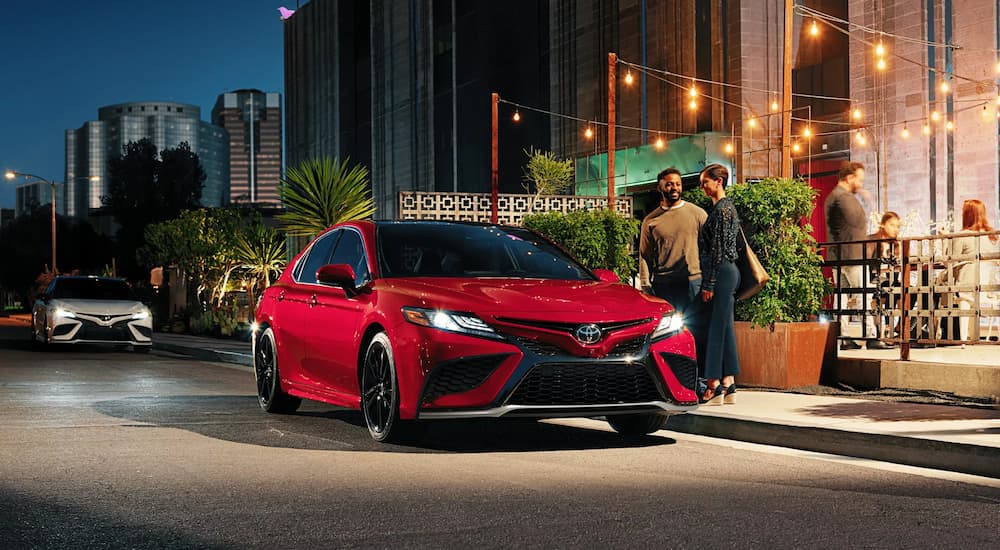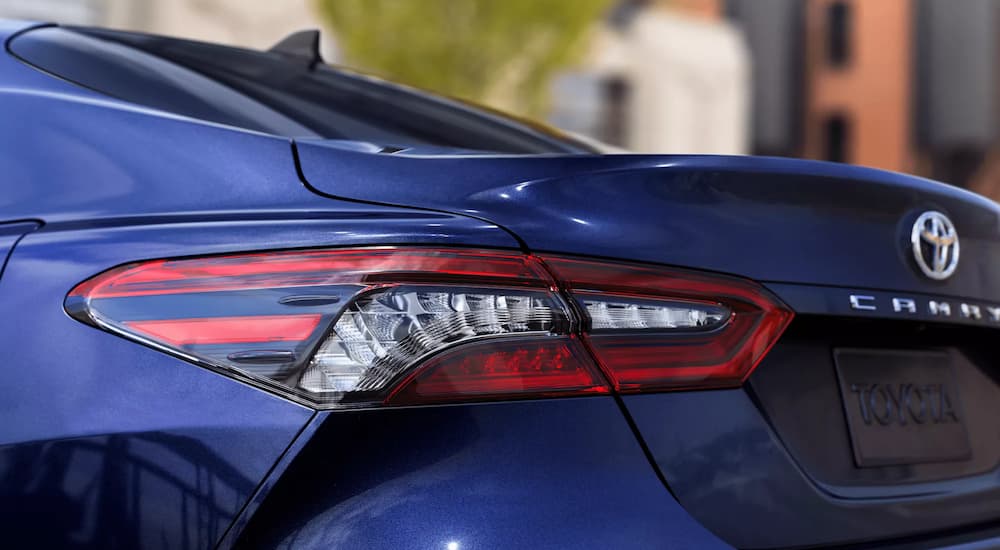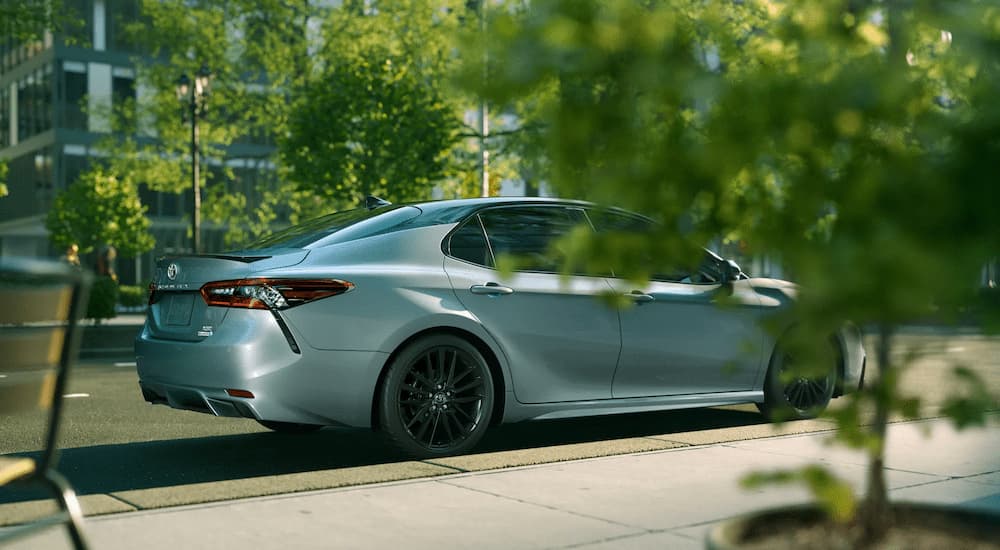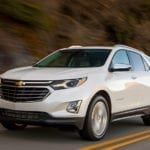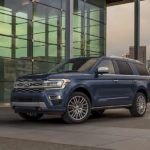Oh, the humble sedan. Despite America’s obsession with SUVs, it still manages to occupy a prominent spot in many automakers’ lineups. Visit a Toyota Camry dealership, and you’ll witness this phenomenon firsthand. Toyota continues bettering the industry’s most popular midsize sedan amidst record-setting crossover sales. But, why?
Officially, automakers will continue building competitive sedans for the 24 percent of buyers who still desire them. Unofficially, many manufacturers are abandoning the sedan body style altogether, investing solely in crossover and SUV models. It may seem like a slow, painful death, but actually, the narrowed playing field means the few remaining sedan options are top-notch.
We don’t care how many people and carry ons you can stuff in your oversized SUV; nothing feels quite as good as entering a hairpin turn behind the wheel of a sleek, aerodynamic sports sedan with a low center of gravity. We challenge any crossover owner to do so with more confidence. Sedans like the Camry XSE perform thrillingly in sport mode, capably optimizing all 301 available horses in grand fashion. Sedans like the Toyota Camry may never catch up to SUVs in sales volume, but when it comes to road handling, no crossover even comes close.
The Real Reason Automakers are Abandoning Sedans
Google sedan popularity and hits one, two, and three will undoubtedly feature clickbait from various self-proclaimed automotive experts predicting the demise of the sedan. Alarming headlines claim the sedan body style is in a death spiral, and manufacturers are quitting the sedan business altogether. While part of that is true, the premise behind it is a little misleading.
In fact, the shrinking sedan market has made room for higher quality entrants. Manufacturers are opting out not because they don’t see a future for sedan models but because they can’t (or won’t) devote the resources necessary to build competitive offerings. Meanwhile, much to the delight of approximately 30% of the car-buying public, a small contingent of devoted manufacturers are doubling down on designing sleek, upscale sedans with impressive performance capability.
Most industry analysts agree that high-quality sedans will survive the SUV onslaught, following a trend previously set by the ubiquitous minivan. You’re still seeing luxurious Toyota Siennas and Honda Odysseys flying off dealer showroom floors; history dictates the same will hold true for the sedan. Toyota executives even went on the record in 2019 for The Detroit News, expressing in no uncertain terms the company’s unequivocal loyalty to building sedans long into the future.
The 2022 Toyota Camry reflects the company’s commitment, with a 13-trim lineup that includes everything from value-priced entry-level trims to hybrid models, as well as a go-fast V6 XSE luxury trim that rivals even the fanciest European imports. While the Big 3 American automakers shift to an SUV-heavy product strategy, most imports still feature a tasty assortment of cars.
Big Name Brands Hang on to Flagship Sedans
Toyota isn’t the only automaker that’s doubled down on the sedan category. Companies like Honda, Hyundai, and Kia have all recently released new versions of old favorites. Hyundai’s wildly popular Elantra was refreshed for 2022, as was the perennial compact favorite, the Honda Civic. It begs the question: why have popular models like these endured when so many other sedans have been discontinued?
German automakers like BMW and Audi have never abandoned their popular sedan lineups. In fact, one can argue that the venerable 7 Series and A8 sedans remain the flagship nameplates in their respective lineups despite a near-continuous cycle of new SUV launches. Even BMW’s 2 Series coupe is the go-to favorite starter luxury vehicle for segment newbies, and though not technically a sedan, it is a car.
Meanwhile, American brands like Lincoln and Buick have gone completely sedan-less. Chevy has rid itself of most sedans, except the midsize Malibu. It hardly counts, though, since fleet sales (e.g., rental car companies) account for the majority of that model’s sales volume. Ford still builds the Mustang, but it’s not a sedan. That puts the Blue Oval at a grand total of zero sedans in the lineup.
Let’s talk about Genesis, Hyundai’s near-luxury premium brand. The G70 and G80 sports sedans are the darlings of the automotive media, with Car and Driver bestowing a 9/10 rating on both vehicles. You will continue to find the reliable Accord at Honda dealerships in the 2022 model year also, and the same holds true for Kia’s wildly popular 300-horsepower Stinger sedan. R.I.P. Mazda6, but you can bet the Mazda3 will stick around for the long haul – especially with its brand-new 250-horsepower turbocharged engine. The theme is undeniable – every automaker but the Big 3 is steadfast.
Why the Camry is a Fan Favorite
Toyota is unapologetic about its commitment to the Camry and its little sibling, the Corolla. What’s behind that loyalty? It’s easy: sales are brisk. First-time buyers struggle to find well-equipped starter crossovers, instead defaulting to a sedan body style. As long as there are budget buyers, there will be value-priced sedans like the Camry.
Remember, 30% of the car-buying public is still saying yes to a sedan. Automakers like General Motors and Ford ignore the category at their own peril. We paid attention when Car and Driver deemed the newest 2022 Camry “arguably the most compelling it has ever been,” calling the available 301 horsepower V6 engine “lusty.” If fuel economy matters, environmentally conscious buyers can even pluck a 53 mpg hybrid model out of the lineup.
The Camry earns its driving accolades – normally reserved for high-performance sedans like BMWs – by way of the TRD trim. Opting for a 2022 Camry TRD gets you exterior extras like a rear spoiler, dual exhaust tips, and a factory lowered suspension to complement the powerful V6 engine. Buyers can even select a set of optional high-performance summer tires.
Luxury seekers aren’t left behind either, thanks to the gorgeous Camry XSE. With the upgraded V6 among the long list of standard features, the XSE rivals far more expensive European sedans with its panoramic moonroof, plush leather seating, and 9-speaker JBL audio system. A wireless smartphone charger, dual-zone climate control, and a set of paddle shifters round out the XSE’s included goodies.
Some Things Still Remain the Same
In a world where supersizing equals quality, it’s good to know that a contingent of automakers still believes in the sedan. Sales may have leveled off, but much like the minivan and the sports coupe (think: Corvette), the market for sedans will never completely die. SUVs and crossovers work for a lot of buyers, but not all. For some drivers, sitting up high and piloting extra bulk isn’t desirable.
The sedan category represents a sweet spot for savvy buyers who see past the utility vehicle craze. It’s here that manufacturers are aggressively competing for precious little market share. Because of the dearth of buyers, competition is fierce, making way for ingenuity and ever-increasing performance capability. Meanwhile, sedan fuel economy ratings remain the best of any vehicle category. Can you stuff eight people in a sedan? No, but that’s not what sedans are designed for.
Trends come and go, but practicality and driving enjoyment never goes out of style. That’s why we’re confident that sedans are here for the long haul. As manufacturers double down on quality and innovation, we can sit back, admire their work, and enjoy being the beneficiaries of some of the best and most advanced vehicles on the road today. What do they have in common? Four doors, sleek lines, and low profiles. Yes, please.
